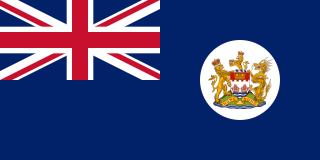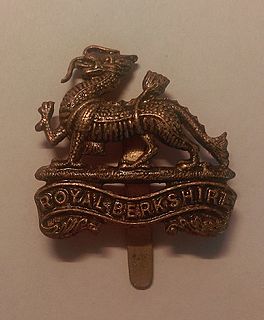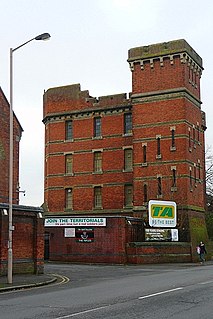
Devizes is a market town and civil parish in the centre of Wiltshire, England. It developed around Devizes Castle, an 11th-century Norman castle, and received a charter in 1141 permitting regular markets, which are held weekly in an open market place. The castle was besieged during the Anarchy, a 12th-century civil war between Stephen of England and Empress Matilda, and again during the English Civil War when the Cavaliers (Royalists) lifted the siege during the Battle of Roundway Down. Devizes remained under Royalist control until 1645, when Oliver Cromwell attacked and forced the Royalists to surrender. The castle was destroyed in 1648 on the orders of Parliament, and today little remains of it.
Options for Change was a restructuring of the British Armed Forces in 1990 after the end of the Cold War.

The Royal Gloucestershire, Berkshire and Wiltshire Regiment was a short-lived infantry regiment of the British Army.
Maurice Albert Wyndham Rogers, VC, MM was a British Army soldier of the Second World War and a recipient of the Victoria Cross, the highest award for gallantry in the face of the enemy that can be awarded to British and Commonwealth forces.

The Devonshire and Dorset Regiment, usually just known as the Devon and Dorsets, was an infantry regiment of the British Army formed in 1958 by the amalgamation of two county regiments, the Devonshire Regiment and the Dorset Regiment. In 2007 it was itself merged into The Rifles, a "large regiment".
The Duke of Edinburgh's Royal Regiment was an infantry regiment of the British Army.

British Forces Overseas Hong Kong comprised the elements of the British Army, Royal Navy and Royal Air Force stationed in British Hong Kong. The Governor of Hong Kong also assumed the position of the Commander-in-chief of the forces and the Commander British Forces in Hong Kong took charge of the daily deployment of the troops. Much of the British military left prior to the handover of Hong Kong to China in 1997. The present article focuses mainly on the British garrison in Hong Kong in the post Second World War era. For more information concerning the British garrison during the Second World War see the Battle of Hong Kong.
The Rifles is an infantry regiment of the British Army. Formed in 2007, it consists of five Regular and three Reserve battalions, plus a number of companies in other Army Reserve battalions. Each battalion of The Rifles was formerly an individual battalion of one of the two large regiments of the Light Division. Since formation the regiment has been involved in combat operations, first in the later stages of the Iraq War and in the War in Afghanistan.

The Royal School of Artillery (RSA), formerly the School of Instruction for Royal Horse and Field Artillery (Larkhill), is the principal training establishment for artillery warfare in the British Army. Established in 1915, it is located at Larkhill, Wiltshire, on the south edge of Salisbury Plain in the United Kingdom. The School is the primary training facility for Royal Artillery recruits, and is also home to the Gunnery Training Team.

Larkhill is a garrison town in the civil parish of Durrington, Wiltshire, England. It lies about 1 3⁄4 miles (2.8 km) west of the centre of Durrington village and 1 1⁄2 mi (2.4 km) north of the prehistoric monument of Stonehenge. It is about 10 mi (16 km) north of Salisbury.

The Wiltshire Regiment was a line infantry regiment of the British Army, formed in 1881 under the Childers Reforms by the amalgamation of the 62nd (Wiltshire) Regiment of Foot and the 99th Duke of Edinburgh's (Lanarkshire) Regiment of Foot.
The Wessex Brigade was an administrative formation of the British Army from 1948 to 1968. The Brigade administered the regular infantry regiments of the Wessex area of south and south west England.

The Royal Berkshire Regiment was a line infantry regiment of the British Army in existence from 1881 until 1959. The regiment was created in 1881, as the Princess Charlotte of Wales's , by the amalgamation of the 49th (Hertfordshire) Regiment of Foot and the 66th (Berkshire) Regiment of Foot. In 1921, it was renamed the Royal Berkshire Regiment .

Bulford Camp is a military camp on Salisbury Plain in Wiltshire, England. Established in 1897, the site continues in use as a large British Army base. The camp is close to the village of Bulford and is about 2 1⁄4 miles (3.6 km) northeast of the town of Amesbury.
In countries whose armies are organised on a regimental basis, such as the army of the United Kingdom, a regimental museum is a military museum dedicated to the history of a specific army regiment.

The 49th (Hertfordshire) Regiment of Foot was a line infantry regiment of the British Army, raised in 1743. Under the Childers Reforms it amalgamated with the 66th (Berkshire) Regiment of Foot to form the Princess Charlotte of Wales's in 1881.

The regimental depot of a regiment is its home base for recruiting and training. It is also where soldiers and officers awaiting discharge or postings are based and where injured soldiers return to full fitness after discharge from hospital before returning to full duty. Normally, a variety of regimental stores will also be kept at the depot. The regimental depot is not the same as the regimental headquarters, though in practice the two will often be co-located in the same place.

Brock Barracks is a British Army barracks in the town of Reading in the English county of Berkshire. Located on Oxford Road in the district of West Reading. The majority of the buildings and structures within Brock Barracks are Grade II listed.

The Fovant Badges are a set of regimental badges cut into a chalk hill, Fovant Down, near Fovant, in southwest Wiltshire, England. They are located between Salisbury and Shaftesbury on the A30 road in the Nadder valley; or approximately 1⁄2 mile (800 m) southeast of Fovant. They were created by soldiers garrisoned nearby, and waiting to go to France, during the First World War; the first in 1916. They are clearly visible from the A30 road which runs through the village. Nine of the original twenty remain, and are scheduled ancient monuments and recognised by the Imperial War Museum as war memorials. Further badges have been added more recently.













